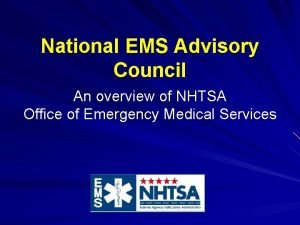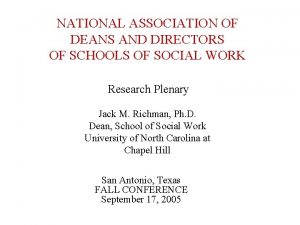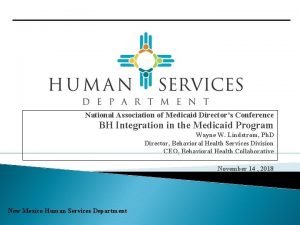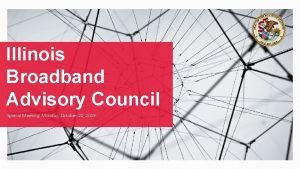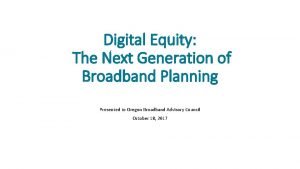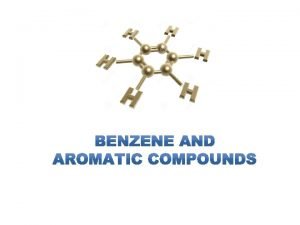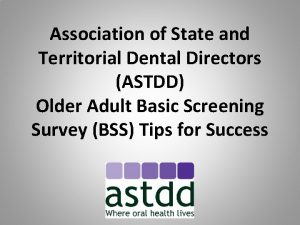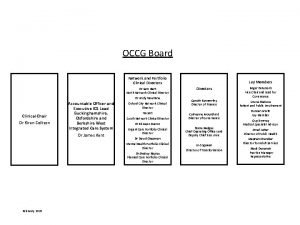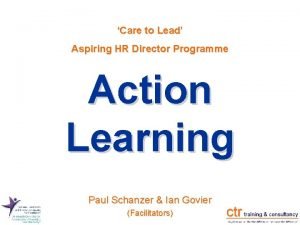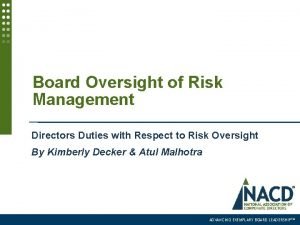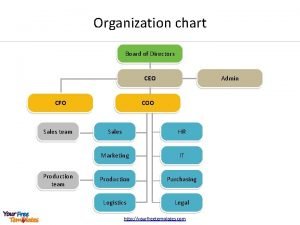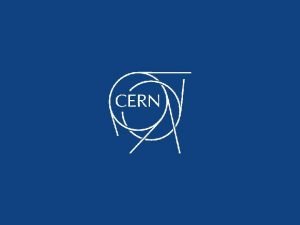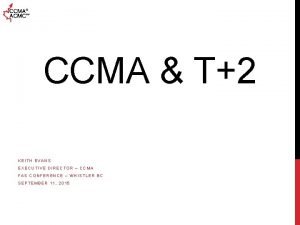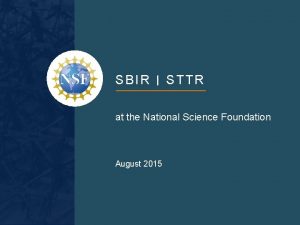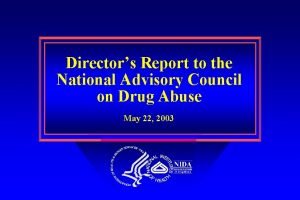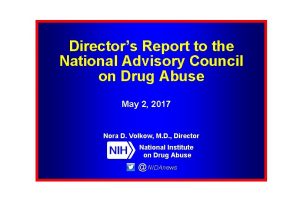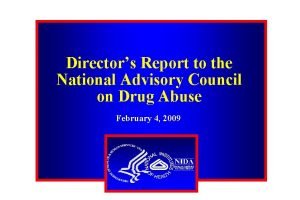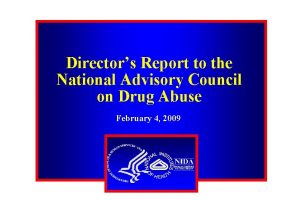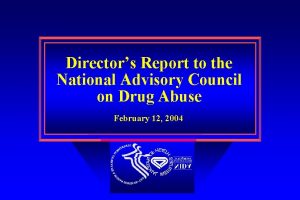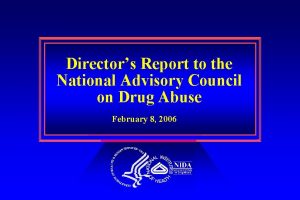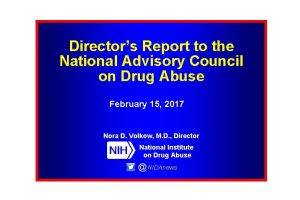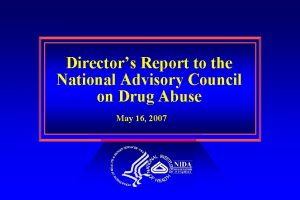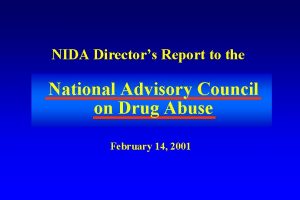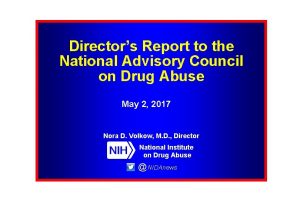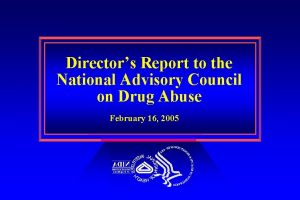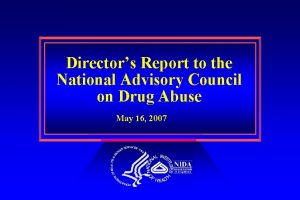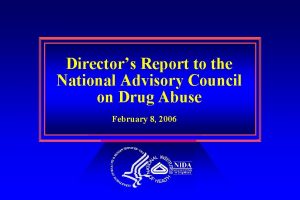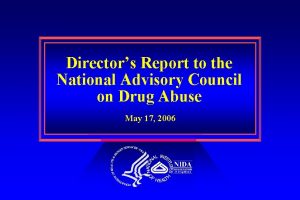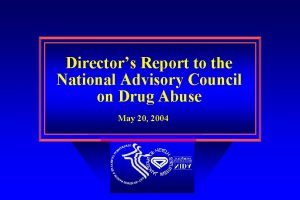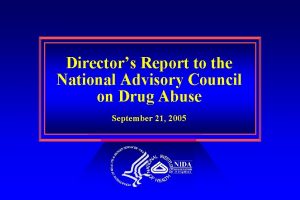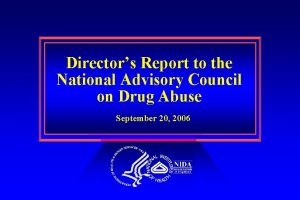Directors Report to the National Advisory Council on








































- Slides: 40

Director’s Report to the National Advisory Council on Drug Abuse February 10, 2016 Nora D. Volkow, M. D. , Director National Institute on Drug Abuse @NIDAnews

NIDA Office of Diversity & Health Disparities Office of the Director Office of Translational Initiatives and Program Innovations Office of Management Center for the Clinical Trials Network Executive Officer Joellen Austin, MPAff, MSM AIDS Research Program International Program Office of Science Policy & Communications Division of Therapeutics and Medical Consequences Intramural Research Program Division of Neuroscience and Behavior Trans-Divisional Research Teams Division of Extramural Research Division of Epidemiology, Services and Prevention Research

NIDA BUDGET (Thousands) Actuals FY 2016 Operating Plan FY 2017 Non. AIDS $716, 833 $756, 306 AIDS $298, 862 $294, 244 TOTAL $1, 015, 695 $1, 050, 550 FY 2015 PB

National Institute on Drug Abuse Portfolio FY 2015 Actual Therapeutics and Medical Consequences Research -- 20% Neuroscience and Behavioral Research – 39% Epidemiology, Services and Prevention Research – 36% Clinical Trials Network – 5% Intramural Research – 9% RM&S -- 6%

Director’s Report to the National Advisory Council on Drug Abuse • Budget Update • What’s New @ HHS/NIH? • Recent NIDA Activities & Events

The BRAIN Initiative® NIH Investment from various Institutes, Centers, and Offices: Fiscal Year FY 14 FY 15 FY 16 FY 17 FY 18 FY 19 Actual Budget $46. 1 M $85 M $150 M* (est. ) *$85 M FY 16 Appropriations increase ACD WG Professional Judgment Budget $100 M $190 M $300 M [churn year] $400 M $500 M • • • • Blueprint NCCIH NEI NIAAA NIBIB NICHD NIDA NIDCD NIMH NINDS OBSSR OD ORWH

BRAIN Projects: 58 in FY 2014 & 67 in FY 2015 Short Courses: 3 awards (MH-15 -215) Cell-Type Classification: 10 awards (MH-14 -215) Novel Tools – Cells and Circuits: 25 awards (MH 14 -216; MH-15 -225) Next Generation Human Imaging: 14 awards (MH -14 -217; MH-15 -200) Next Generation Human Invasive Devices (2 RFAs): 3 awards (NS-15 -006/008) Large-scale Recording & Modulation (5 RFAs): 53 awards (NS-14 -007/008; NS-15 -003/004; EY-15 -001) Integrating Approaches to Understand Circuit Function: 17 awards (NS-14 -009; NS-15 -005)

BRAIN Funding in FY 2016: Opportunities Short Courses: (MH-16 -700) Novel Tools – Cells and Circuits: (MH-16 -775) Foundations of Human Imaging: (MH-16 -750) Next Generation Human Invasive Devices: (NS-16 -009/010/011/018) Large-scale Recording & Modulation: (NS-16 -006/007; EY-16 -001) Research Opportunities Invasive Neural Recording: (NS-16 -008) Non-invasive Neuromodulation: (MH-16 -810/815) Technology Sharing and Propagation: (MH-16 -725) Theories, Models, Methods: (EB-15 -006)

• For 2016, the President proposed that $215 million to the PMI $130 million will be used to start building the PMI research cohort. • A PMI Working Group of the Advisory Committee to the NIH Director (ACD), was established to plan the creation and management of the PMI research cohort. Recommendations delivered to ACD in Sept 2015. • • PMI Cohort Program Coordinating Center (U 2 C) (RFA-PM-16 -001) Issued: Nov 16, 2015 PMI Cohort Program Healthcare Provider Organization Enrollment Centers (UG 3/UH 3) (RFA-PM-16 -002) Issued: Nov 16, 2015 PMI Cohort Program Participant Technologies Center (U 24) (RFA-PM-16 -003) Issued Nov 16, 2015 PMI Cohort Program Biobank (U 24) (RFA-PM-16 -004) Issued Nov 16, 2015

Recruitment for NIMH Director ANNOUNCEMENT DEC 7, 2015

OBJECTIVES: RELEASED: December 16, 2015 1. advance opportunities in biomedical research in fundamental science, treatment and cures, and health promotion and disease prevention; 2. foster innovation by setting NIH priorities to enhance nimbleness, consider burden of disease and value of permanently eradicating a disease, and advance research opportunities presented by rare diseases; 3. enhance scientific stewardship by recruiting and retaining an outstanding biomedical research workforce, enhancing workforce diversity and impact through partnerships, ensuring rigor and reproducibility, optimizing approaches to inform funding decisions, encouraging innovation, and engaging in proactive risk management practices; and 4. excel as a federal science agency by managing for results by developing the “science of science, ” balancing outputs with outcomes, conducting workforce analyses, continually reviewing peer review, evaluating steps to enhance rigor and reproducibility, reducing administrative burden, and tracking effectiveness of risk management in decision making.

Released December 2015!

Goals 1. Basic Science: Identify the biological, environmental, behavioral, and social causes and consequences of drug use and addiction across the lifespan 2. Prevention: Develop new and improved strategies to prevent drug use and its consequences 3. Treatment: Develop new and improved treatments to help people with substance use disorders achieve and maintain a meaningful and sustained recovery 4. Public Health: Increase the public health impact of NIDA research and programs Priority Areas 1. Understanding the complex interactions of factors influencing drug use trajectories 2. Accelerating development of treatments 3. Addressing real-world complexities 4. Advancing bidirectional translation

Director’s Report to the National Advisory Council on Drug Abuse • Budget Update • What’s New @ HHS/NIH? • Recent NIDA Activities & Events

Priority Areas Prevention Research (Children & Adolescents) genetics/epigenetics development environment co-morbidity

2015 Monitoring the Future Study Prevalence of Past Year Drug Use Among 12 th graders Drug Prev. Alcohol 58. 2 Vicodin* 4. 4 Marijuana/Hashish 34. 9 Hallucinogens 4. 2 Hookah 19. 8 Oxy. Contin* 3. 7 Small cigars 15. 9 Sedatives* 3. 6 Amphetamines* 7. 7 MDMA (Ecstasy) 3. 6 Adderall* 7. 5 LSD 2. 9 Snus 5. 8 Hall other than LSD 2. 9 Narcotics o/t Heroin* 5. 4 Cocaine (any form) 2. 5 Synthetic Cannabinoids 5. 2 Ritalin* 2. 0 Tranquilizers* 4. 7 Inhalants 1. 9 Cough Medicine* 4. 6 Salvia 1. 9 * Nonmedical use Categories not mutually exclusive

% Students Reporting Use of Synthetic Cannabinoids in Past Year % Students Reporting Use of Heroin in Past Year 20 20 15 15 10 10 5 5 0 0 2012 8 th Grade 2013 2014 10 th Grade 95 96 97 98 99 00 01 02 03 04 05 06 07 08 09 10 11 12 13 14 15 2015 12 th Grade 8 th Grade 10 th Grade 12 th Grade SOURCE: University of Michigan, 2015 Monitoring the Future Study

% Students Reporting Smoking Cigarettes in Lifetime, by Grade 100 40 80 30 60 20 40 10 20 0 %Students Reporting Daily Cigarette Use 91 92 93 94 95 96 97 98 99 00 01 02 03 04 05 06 07 08 09 10 11 12 13 14 15 8 th Grade 10 th Grade 12 th Grade 0 91 92 93 94 95 96 97 98 99 00 01 02 03 04 05 06 07 08 09 10 11 12 13 14 15 8 th Grade 10 th Grade 12 th Grade Denotes significant difference between 2014 and 2015 SOURCE: University of Michigan, 2015 Monitoring the Future Study`

% Students Reporting Use of Alcohol Past Year % Students Reporting 5+ Drinks in a Row in Last Two Weeks 100 80 80 60 60 40 40 20 20 0 93 94 95 96 97 98 99 00 01 02 03 04 05 06 07 08 09 10 11 12 13 14 15 8 th Grade 10 th Grade 12 th Grade 0 91 92 93 94 95 96 97 98 99 00 01 02 03 04 05 06 07 08 09 10 11 12 13 14 15 8 th Grade 10 th Grade 12 th Grade SOURCE: University of Michigan, 2015 Monitoring the Future Study

% Students Reporting Use of Marijuana in Past Year % Students Reporting Daily Use of Marijuana 20 100 80 15 60 10 40 5 20 0 91 92 93 94 95 96 97 98 99 00 01 02 03 04 05 06 07 08 09 10 11 12 13 14 15 8 th Grade 10 th Grade 12 th Grade SOURCE: University of Michigan, 2015 Monitoring the Future Study

Source of Marijuana* among 12 th Graders in 2012 -2015, by State Policy 100 80 60 40 ** 20 ** ** ** 0 ve Gi x d d x d er ve ve ve ien JR JR tho ng ati ati r r l l l e a f f M M e e e r M M ht tr ok rm /st kr nr ug gh To wn he e's ve ler oo t i o u s a T O l B O G e de Bo ne ht o g u me Bo So nd rie f n Medical Marijuana States *Categories not mutually exclusive ** Statistically significant difference Non-Medical Marijuana States SOURCE: University of Michigan, 2015 Monitoring the Future Study

Adolescent Brain Cognitive Development (ABCD) An NIH Collaboration: NIDA, NIAAA, NCI, NIMH, NIMHD, NICHD, NINDS, OBSSR

Priority Areas Prevention Research (Children & Adolescents) genetics/epigenetics development environment co-morbidity Treatment Interventions (New Targets & New Strategies)

Heroin Overdose Deaths in the USA Opioid Analgesic Overdose Deaths in the USA 20, 000 18, 893 18, 000 16, 917 16, 235 16, 651 16, 007 15, 597 16, 000 14, 800 14, 408 13, 723 14, 000 12, 000 10, 574 10, 000 8, 257 8, 000 10, 928 9, 857 10, 000 8, 517 8, 000 5, 925 6, 000 7, 456 4, 397 4, 000 4, 400 4, 030 2, 000 04 20 05 20 06 20 07 20 08 20 09 20 10 20 11 20 12 20 13 20 14 03 20 02 20 20 20 19 01 0 00 02 20 03 20 04 20 05 20 06 20 07 20 08 20 09 20 10 20 11 20 12 20 13 20 14 01 20 00 20 20 19 99 0 2, 399 2, 0892, 080 2, 0092, 088 1, 9601, 842 1, 878 1, 779 99 2, 000 3, 278 3, 041 3, 036 20 5, 528 6, 000 4, 000 12, 000 Centers for Disease Control and Prevention. Wide-ranging Online Data for Epidemiologic Research (WONDER), Multiple-Cause-of-Death file, 2000– 2014. 2015 (http: //www. cdc. gov/ nchs/ data/health_policy/ AADR_drug_poisoning_involving_OA_Heroin_US_2000 -2014. pdf)

HHS Strategy To Address Opioid-Drug Related Overdose, Death and Dependence • Providing training and educational resources, including updated prescriber guidelines, to assist health professionals in making informed prescribing decisions • Increasing use of naloxone • Expanding the use of Medication-Assisted Treatment (MAT)

Opioid Prescribing After a Nonfatal OD: Association With Repeated Overdose (n=2900) Repeated OD Despite the fact that opioid discontinuation after overdose is associated with lower risk for repeated overdose almost all patients continue to receive prescription opioids after an overdose. Larochelle, et al, Ann Intern Med. 2016; 164(1): 1 -9.

Coordinated by NIDA as part of NIH’s Pain Consortium, the Centers of Excellence in Pain Education (Co. EPEs) act as hubs for the development, evaluation, and distribution of pain management curriculum resources for medical, dental, nursing, and pharmacy schools. Centers must develop materials to create one case-based education module per year as the main deliverable. The Co. EPEs must also test the efficacy and impact of these modules and disseminate their findings. 11 Co. EPEs funded in September 2015: University of Alabama at Birmingham University of California, San Francisco University of Connecticut Harvard University of Iowa Johns Hopkins University of Pennsylvania University of Pittsburgh University of Rochester Southern Illinois University Edwardsville University of Washington.

Opioid OD Death were Reduced In Communities that Implemented Nasal Naloxone Distribution Program Intranasal Naloxone Administration By Police First Responders In Ohio Unadjusted Unintentional Opioid-Related Overdose Death Rates Unadjusted Opioid-Related Acute Care Hospital Utilization Rates Walley AY et al. , BMJ 2013; Published 31 January 2013. Intranasal naloxone administration by police first responders is associated with decreased OD deaths Rando et al. , Am J Emerg Medicine 2015.

Easier To Administer Naloxone • Naloxone Nasal Spray Development Needle-free, unit-dose, ready-to-use opioid overdose antidote. Ø Adapt Pharma NARCAN nasal spray APPROVED BY FDA, November 18, 2015. • $37. 50 per 4 mg NARCAN Nasal Spray device. Image courtesy of ADAPT Pharma, Inc.

NEW THERAPEUTICS for Opioid Use Disorder Extended release medications (improve compliance) IMPLANTABLE Buprenorphine Probuphine™ (6 months) EVA polymer Buprenorphine Probuphine® 26 mm long, 2. 5 mm diameter FDA’s Final Decision Expected February 27, 2016 IMPLEMENTATION SCIENCE Expanding MAT ED-initiated Buprenorphine Increased Engagement In Addiction Treatment, Reduced Self-reported Illicit Opioid Use, & Decreased Use Of Inpatient Addiction Treatment Services % engaged in TX 30 th day post randomization 100 D’Onofrio JAMA. 2015. 80 78 60 40 20 37 45 0 Referral Brief Intervention Buprenorphine

Methadone Continuation Versus Forced Withdrawal On Incarceration In A Combined US Prison and Jail: A Randomized, Open-label Trial Continuation of methadone maintenance during incarceration as compared to forced withdrawal increased the likelihood of re-engaging in methadone treatment Rich et al. , The Lancet Published online May 29, 2015.

Priority Areas Prevention Research ` (Children & Adolescents) genetics/epigenetics development environment co-morbidity Treatment Interventions (New Targets & New Strategies) HIV and Drugs Prevention Treatment

NIH Overarching AIDS Research Priorities (August 12, 2015) Critical to ensure that NIH AIDS funds are supporting the highest priorities for next 3 -5 years: 1. Reduced incidence, including vaccines 2. Next generation of HIV therapies with better safety and ease of use 3. Research toward a cure 4. HIV-associated comorbidities and co-infections Cross cutting areas: Basic research, health disparities, and training

NIDA Council HIV Workgroup Eric Verdin, M. D. Gladstone Institutes Davey Smith, M. D. UCSD Steffanie Strathdee, Ph. D. Nichole Klatt, Ph. D. UCSD U of Washington Judy Auerbach, Ph. D. Carlos del Rio, M. D. UCSF Emory Univ James Hildreth, MD, Ph. D. Lisa Metsch, Ph. D. Meharry Medical College Columbia Julio Montaner, M. D. UBC Anto Bonci, M. D. NIDA IRP Justin Mc. Arthur, Ph. D. Johns Hopkins First meeting September 22, 2015 Charged with providing advice and making recommendations on future directions for NIDA’s HIV/AIDS research priorities. Suggestions contributed to NIDA’s issuing 5 RFAs in FY 16 & 5 RFAs for FY 17. Next meeting late spring to work on new areas for FY 18

New NIDA FOA HIV/AIDS High Priority Drug Abuse Research (R 01) (PAS-16 -018) Issued: October 30, 2015. To stimulate high priority research relevant to drug abuse and HIV/AIDS including: • • Studies on optimization of seek, test, treat, & retain (STTR) : Reduced incidence • Studies on drug-drug interactions between current or potential new HIV/AIDS antiretrovirals & drugs of abuse, medications to treat addiction, & hepatitis C (HCV) medications: HIVassociated comorbidities • Studies to determine how exposure to drugs & cycles of abuse & withdrawal affect latency & reservoir size and persistence: HIV-associated comorbidities Implementation research on integration of drug abuse treatment and HIV care to optimize HIV outcomes: HIV-associated comorbidities • Implementation of STTR in prison & jail settings (where minorities are disproportionately represented) and upon release: HIV-associated comorbidities

Fiscal Year 16 FOAs u RFA: Effects of drugs of abuse on latent HIV reservoirs in CNS u RFA: Exploring Epigenomic and Non-Coding RNA Regulation in HIV/AIDS and Substance Abuse u RFA: Systems Biology Approaches in HIV/AIDS and Substance Use u RFA: Integration of Infectious Diseases and Substance Abuse Intervention Services for individuals Living with HIV u RFA: Seek, Test, Treat, and Retain for youth and Young Adults living with or at High Risk for Acquiring HIV Fiscal Year 17 FOAs u RFA: Mechanisms of Immune Activation and Inflammation in Drug-Abusing HIV-Infected Patients on ART u RFA: Mobilizing Seek, Test, Treat and Retain Approaches in Rural Injection Drug Use Epidemics u RFA: Seek, Test, Treat, Retain: Optimizing the HIV Care Continuum for Substance Abusing Populations Living with HIV u Implication of Nicotinic receptors’ Regulation of Immune Functions in HIV Infectivity and Pathogenesis u Coordination Center for HIV/AIDS & Substance Use Cohorts

National Drug & January 25 -31, 2016 Alcohol Facts Week - We are happy that NIAAA joined us this year for an expanded National Drug Facts Week - We broke all records and stimulated more than 2000 events around the country and in 14 other countries -- some of the international events were stimulated by our Humphrey Fellows - We created toolkits if event holders wanted to focus on specific drugs, like tobacco, alcohol or synthetics • January 26, 2016 • Held remotely because of the storm • NIAAA, NIMH and FDA CTP also participated • Over 7, 000 questions were submitted -- nearly 1, 500 were answered • The transcript can soon be found on the “NIDA for Teens” Website


Principles of Substance Abuse Prevention for Early Childhood • Fourth in a series of evidence-based principles produced by NIDA: • Principles of Drug Addiction Treatment • Principles of Adolescent Substance Use Disorder Treatment • Principles of Drug Abuse Treatment for Criminal Justice Populations • Supplemental sections for researchers, policymakers and practitioners. • Web-based with easy-to-navigate, print-friendly chapters viewable on desktop, phone or tablet. • Selected resources with information on research-based early childhood drug prevention programs.

Modafinil for the Treatment of Cocaine Dependence Modafinil-Treated Subjects’ Ratings of “very much improved” 50 3 40 2. 5 30 Odds Ratio % Subjects Cocaine Abstinent Percent Of Subjects Abstinent From Cocaine During Weeks 6– 8 23 20 10 9 2 Modafinil Placebo 1. 93 1. 5 1 0. 5 0 0 2. 69 Nurse Practitioner Ratings Self Ratings Kampman KM et al. , Drug and Alcohol Dependence Volume 155, 1 October 2015, Pages 105– 110.
 National ems advisory council
National ems advisory council National association of deans and directors
National association of deans and directors National association of state medicaid directors
National association of state medicaid directors Ciogino sach
Ciogino sach Cadet advisory council
Cadet advisory council Source selection
Source selection President's advisory council on financial capability
President's advisory council on financial capability Illinois broadband advisory council
Illinois broadband advisory council German advisory council on global change
German advisory council on global change Oregon broadband advisory council
Oregon broadband advisory council Advocator of learning without burden
Advocator of learning without burden Advisory expert group on national accounts
Advisory expert group on national accounts National mathematics advisory panel
National mathematics advisory panel Annulene aromaticity
Annulene aromaticity Ciso dashboard ppt
Ciso dashboard ppt Namata board of directors
Namata board of directors Director brief
Director brief Joint medical holdings
Joint medical holdings Directors emma wolverson
Directors emma wolverson Omig ny gov
Omig ny gov Board advisory services
Board advisory services Astdd
Astdd Blade runner german expressionism
Blade runner german expressionism Clinical directors network
Clinical directors network Lvmh board members
Lvmh board members Aspiring directors programme
Aspiring directors programme Board of directors risk oversight responsibilities
Board of directors risk oversight responsibilities Thai institute of directors association
Thai institute of directors association Nancy maher
Nancy maher Perfectionist directors
Perfectionist directors Chief growth officer org chart
Chief growth officer org chart Classification of directors
Classification of directors Perfectionist directors
Perfectionist directors Introduction to hospitality 7th edition
Introduction to hospitality 7th edition Anjli dudani
Anjli dudani Westinghouse board of directors
Westinghouse board of directors Section 11 company directors disqualification act
Section 11 company directors disqualification act Welcome 2 directors
Welcome 2 directors Ccma board of directors
Ccma board of directors Ieee board of directors
Ieee board of directors The national science foundation
The national science foundation
